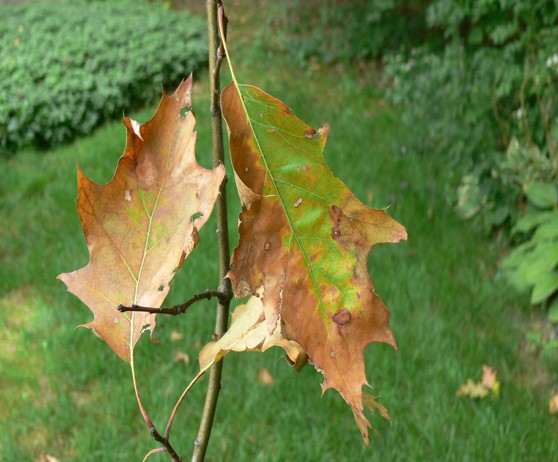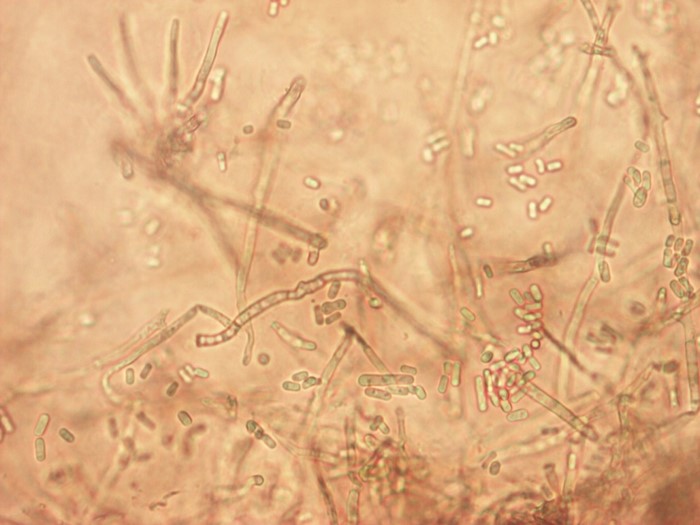Plant disease clinic identifies new case of oak wilt
By Krishna Ramanujan

Earlier this year, the Cornell University Plant Disease Diagnostic Clinic (CU-PDDC) used a new rapid test they developed to identify a small number of oak trees with oak wilt disease on Long Island, in the town on Central Islip.
This is a significant find and only the second location and third time that oak wilt has been identified in New York state, as it was confirmed in Schenectady County in 2008 and again in 2013, said Karen Snover-Clift, director of CU-PDDC, which collaborates closely with the New York State Department of Environmental Conservation (DEC) and the Department of Agriculture and Markets (NYSDAM) by providing diagnoses and research on plant diseases.
“We’ve been fortunate that we’ve caught this infection early,” Snover-Clift said. “Oak wilt is a huge threat. It is similar to other diseases that people have heard of like Dutch elm disease and chestnut blight, which came in and wiped out all those trees.”
This year, oak samples were submitted to the Cornell diagnostic clinic by an arborist who was working on a client’s trees on private land, where he noticed a few oaks were having problems. He had ruled out a number of other common problems on these oaks and then found CU-PDDC oak wilt identification materials available online, funded through the Specialty Crop Block Grant Program through NYSDAM, which also alerted him to send in oak samples to the Cornell clinic for diagnosis.
In April, the DEC removed the four trees from the new site that tested positive for the oak fungus, chipped them and disposed of the chips.
The DEC has issued an emergency order that establishes a protective zone prohibiting the removal of living and dead oaks, unless the wood has been chipped to less than one inch in two dimensions. Also, the DEC order creates a 150-foot “red oak free zone” surrounding the area where the infected trees were discovered. In coming months, the DEC will remove all red oaks in these zones to protect remaining oaks in the area. Residents have been encouraged to report any sudden losses of oak tree leaves they observe.

There is no known cure for oak wilt, which is caused by a fungus, Ceratocystis fagacearum, that gums up and plugs water-conducting vessels in the tree, causing leaves to wilt and fall, leading to the tree’s death. The fungus is only contagious during warm months between April and November. If a tree is infected, the only recourse is to remove it and hope that it hasn’t already infected healthy trees surrounding it, Snover-Clift said.
The Cornell clinic implemented the new oak wilt test as part of the project to determine if the pathogen can be found directly from tissue samples. The most common identification method attempts to isolate the pathogen from wood chips, which requires a lengthy grow out period of up to one month. The new test uses a molecular biology technology called polymerase chain reaction (PCR), which amplifies a single copy or a few copies of a piece of DNA across several orders of magnitude. The Cornell clinic developed and evaluated the new test beginning in 2014 with the two year, $80,000 Specialty Crop Block Grant.
The new PCR test allows for much faster answers and is used in conjunction with the standard isolation method. “In our business, accuracy is extremely important and having multiple tools for identification is ideal,” Snover-Clift said.
The best way to prevent the spread of oak wilt is to educate the public, said Snover-Clift. Along with the clinic’s online oak wilt materials, Snover-Clift and colleagues conduct meetings and give presentations around the state.
Members of the public may also visit the DEC website for information about oak wilt. To report oak wilt, email the DEC Forest Health office or call 1-866-640-0652.
The CU-PDDC is a facility of the School of Integrative Plant Science in the Section of Plant Pathology and Plant-Microbe Biology.
Media Contact
Get Cornell news delivered right to your inbox.
Subscribe